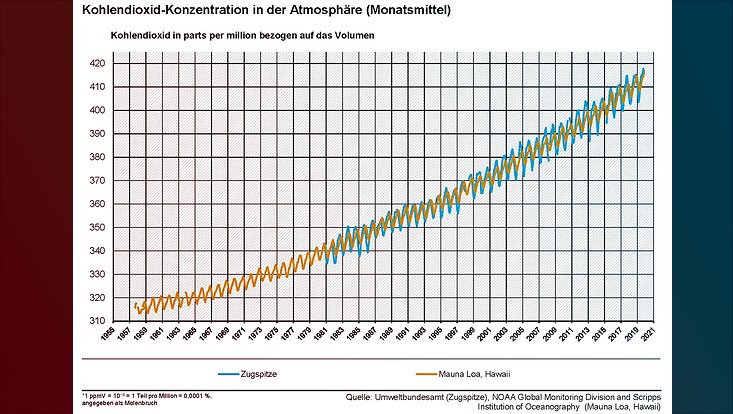Society Research
Despite Corona, the CO2 content of the atmosphere is still on record course - Statement by the DKK
18 May 2020, by CSS

Photo: Umweltbundesamt
Due to the shutdown, greenhouse gas emissions will decrease in the short term, but the CO2 concentration in the atmosphere will continue to rise - possibly only slightly more slowly. This is also shown by the measured values from the Federal Environment Agency in Germany. The German Climate Consortium, of which the CSS is a member institution, therefore emphasises in its statement how important a consistent climate policy is right now.
In March of this year, the concentration of carbon dioxide (CO2) in the atmosphere at the Federal Environment Agency (UBA) measuring station on Zugspitze mountain climbed to almost 418 ppm (particles per million particles of air) on a monthly average for the first time. The new peak value of 417.838 ppm was thus almost 3 ppm higher than in 2019, and the concentration for the month of April was also higher than in the previous year at 415.779 ppm. Data from the oldest CO2 measuring station Mauna Loa in Hawaii confirm this development: The US weather authority NOAA reports an average value of 416.21 ppm for April, an increase of 2.88 ppm compared to 2019. A new record is also expected for May. This value of atmospheric CO2 concentration is mainly responsible for the rise in temperature.
Short-term reductions have no demonstrable effect on climate change
According to initial estimates by the International Energy Agency (IEA), the global shutdown could reduce CO2 emissions from fossil energy sources by about eight percent globally this year. This would be the largest annual reduction since the end of the Second World War. But emissions are still so high that the CO2 content of the atmosphere has risen to new record levels. This shows that a single year of emission reductions has no demonstrable effect on climate development. Only by continuously reducing CO2 emissions can climate change be slowed down. This requires an annual reduction in CO2 emissions in the coming decades on the scale caused by the shutdown. According to the Intergovernmental Panel on Climate Change, global CO2 emissions must fall to zero net by the middle of the century if the 1.5 degree target is to be achieved. Professor Mojib Latif, climate researcher and chairman of the board of the German Climate Consortium (DKK), says: "The short break due to the shutdown is by far not enough to steer climate development on a path that corresponds to the Paris climate target. What is needed is a constant reduction in emissions on this scale in the coming years - without paralysing the economy in the process".
The scale of transformation requires permanent, structural changes
In order to do justice to the scale of this task, permanent, structural changes are needed in all areas of society - from the energy system to land use and infrastructure, as outlined in the IPCC's Special Report on the 1.5 degree target. The later the transformation begins, the more difficult it becomes. It is important for us, as researchers of the scientific association with 25 renowned member institutions for climate and climate impact research, to point this out. And we say this deliberately in view of the debates on the economic aid programmes. In dealing with the Covid 19 crisis, it is now a matter of a competition of the best ideas on how to promote the economy and at the same time significantly reduce CO2 emissions.
The apparent contradiction has to do with the long retention time of CO2 in the atmosphere
The fact that the CO2 content of the atmosphere continues to rise even as emissions fall is due to the very long time carbon dioxide remains in the atmosphere. Even though the oceans and land regions currently absorb slightly more than half of the CO2 emitted by humanity, according to the Global Carbon Project, the rest will remain in the air for about a century. Only a complete and permanent halt to emissions will lead to a stabilisation of the CO2 content and, in the longer term, to its reduction. With regard to seasonal fluctuations, it is important to note that the highest monthly average of CO2 concentration in Germany usually occurs in March, shortly before plants begin to bind large amounts of CO2 during the growing season in the northern hemisphere. On the global scale, the peak is in May. In the northern autumn, winter and early spring, plants and soils release this CO2 again, causing values to rise again within the natural range of fluctuation. To determine the long-term trend for climate development, one can compare the average of the same month of different years or different annual averages.
You can find more information and helpful links on the website of the DKK here [in German]


